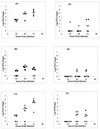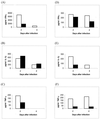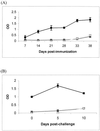Model of differential susceptibility to mucosal Burkholderia pseudomallei infection
- PMID: 11796576
- PMCID: PMC127661
- DOI: 10.1128/IAI.70.2.504-511.2002
Model of differential susceptibility to mucosal Burkholderia pseudomallei infection
Abstract
Burkholderia pseudomallei is the causative agent of melioidosis, an infectious disease with protean clinical manifestations. The major route of infection is thought to be through subcutaneous inoculation of contaminated soil and water, although ingestion and inhalation of contaminated aerosols are also possible. This study examines infection through the intranasal route in a murine model to mimic infection through inhalation. Two strains of mice, C57BL/6 and BALB/c, exhibit differential susceptibilities to the infection, with the C57BL/6 mice being considerably more resistant. To examine host factors that could contribute to this difference, bacterial loads and cytokine profiles in the two strains of mice were compared. We found that infected BALB/c mice exhibited higher bacterial loads in the lung and spleen and that they produced significantly higher levels of gamma interferon (IFN-gamma) in the serum than C57BL/6 mice. Although tumor necrosis factor alpha and interleukin-1 could be detected in the nasal washes and sera of both strains of mice, the production in serum was transient and much lower than that of IFN-gamma. C57BL/6 mice also exhibited memory responses to bacteria upon reinfection, with the production of serum immunoglobulin G (IgG) and mucosal IgA antibodies. Thus, it is possible that the production of systemic and mucosal antibodies is important for protection against disease in C57BL/6 mice.
Figures




Similar articles
-
Cytokine gene expression in innately susceptible BALB/c mice and relatively resistant C57BL/6 mice during infection with virulent Burkholderia pseudomallei.Infect Immun. 2000 Apr;68(4):2034-42. doi: 10.1128/IAI.68.4.2034-2042.2000. Infect Immun. 2000. PMID: 10722599 Free PMC article.
-
Dysregulation of TNF-α and IFN-γ expression is a common host immune response in a chronically infected mouse model of melioidosis when comparing multiple human strains of Burkholderia pseudomallei.BMC Immunol. 2020 Feb 3;21(1):5. doi: 10.1186/s12865-020-0333-9. BMC Immunol. 2020. PMID: 32013893 Free PMC article.
-
The innate interferon gamma response of BALB/c and C57BL/6 mice to in vitro Burkholderia pseudomallei infection.BMC Immunol. 2006 Aug 18;7:19. doi: 10.1186/1471-2172-7-19. BMC Immunol. 2006. PMID: 16919160 Free PMC article.
-
Induction of multiple chemokine and colony-stimulating factor genes in experimental Burkholderia pseudomallei infection.Immunol Cell Biol. 2001 Oct;79(5):490-501. doi: 10.1046/j.1440-1711.2001.01038.x. Immunol Cell Biol. 2001. PMID: 11564157
-
Interaction between Burkholderia pseudomallei and the host immune response: sleeping with the enemy?J Infect Dis. 2005 Nov 15;192(10):1845-50. doi: 10.1086/497382. Epub 2005 Oct 7. J Infect Dis. 2005. PMID: 16235187 Review.
Cited by
-
The art of persistence-the secrets to Burkholderia chronic infections.Pathog Dis. 2016 Aug;74(6):ftw070. doi: 10.1093/femspd/ftw070. Epub 2016 Jul 19. Pathog Dis. 2016. PMID: 27440810 Free PMC article. Review.
-
Extended loop region of Hcp1 is critical for the assembly and function of type VI secretion system in Burkholderia pseudomallei.Sci Rep. 2015 Feb 4;5:8235. doi: 10.1038/srep08235. Sci Rep. 2015. PMID: 25648885 Free PMC article.
-
Immunostimulatory CpG oligodeoxynucleotide confers protection in a murine model of infection with Burkholderia pseudomallei.Infect Immun. 2004 Aug;72(8):4494-502. doi: 10.1128/IAI.72.8.4494-4502.2004. Infect Immun. 2004. PMID: 15271908 Free PMC article.
-
Evaluation of surrogate animal models of melioidosis.Front Microbiol. 2010 Dec 29;1:141. doi: 10.3389/fmicb.2010.00141. eCollection 2010. Front Microbiol. 2010. PMID: 21772830 Free PMC article.
-
Abandon the mouse research ship? Not just yet!Shock. 2014 Jun;41(6):463-75. doi: 10.1097/SHK.0000000000000153. Shock. 2014. PMID: 24569509 Free PMC article.
References
-
- Appelberg, R. 1994. Protective role of interferon gamma, tumor necrosis factor alpha and interleukin-6 in Mycobacterium tuberculosis and M. avium infections. Immunobiology 191:520–525. - PubMed
-
- Ashdown, L. R. 1979. An improved screening technique for isolation of Pseudomonas pseudomallei from clinical specimens. Pathology 11:293–297. - PubMed
-
- Bancroft, G. J., R. D. Schreiber, G. C. Bosma, M. J. Bosma, and E. R. Unanue. 1997. A T cell-independent mechanism of macrophage activation by interferon-γ. J. Immunol. 139:1104–1107. - PubMed
Publication types
MeSH terms
Substances
LinkOut - more resources
Full Text Sources
Molecular Biology Databases
Miscellaneous

